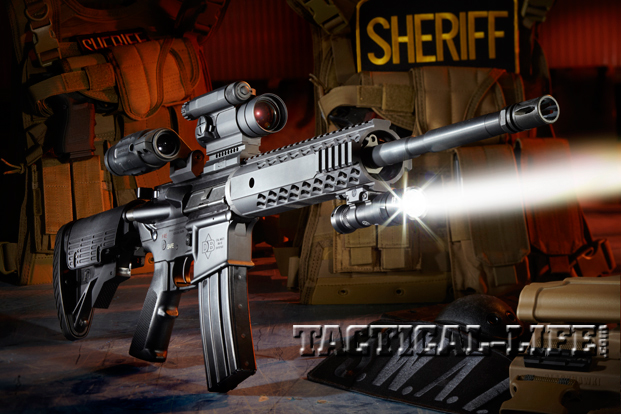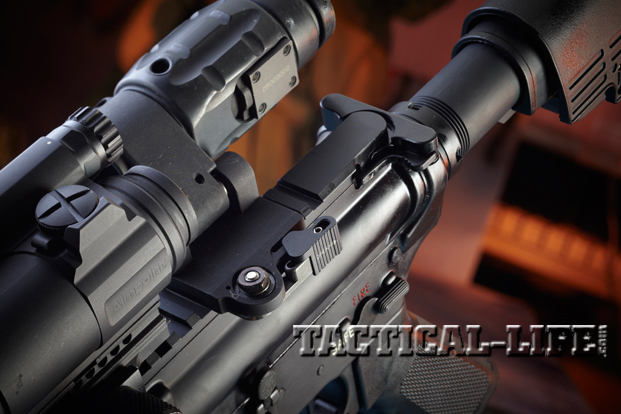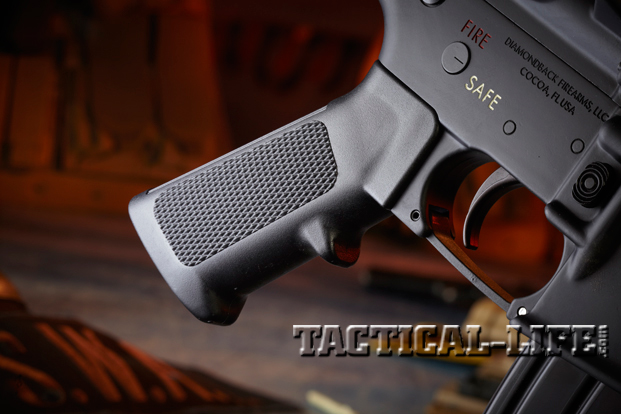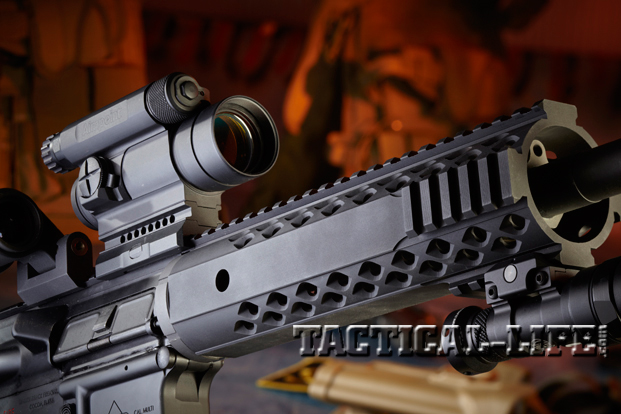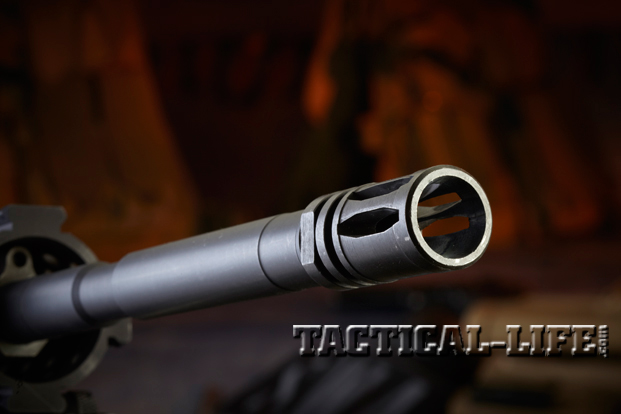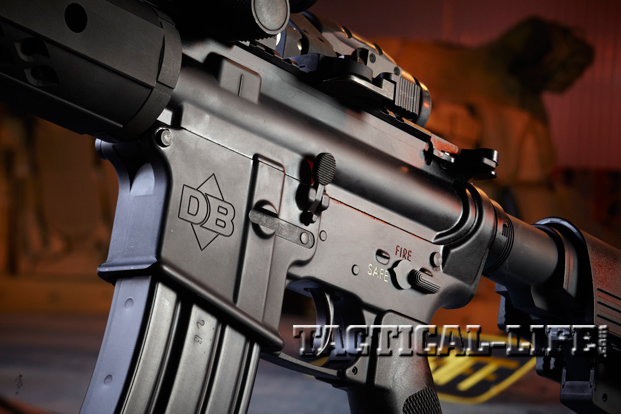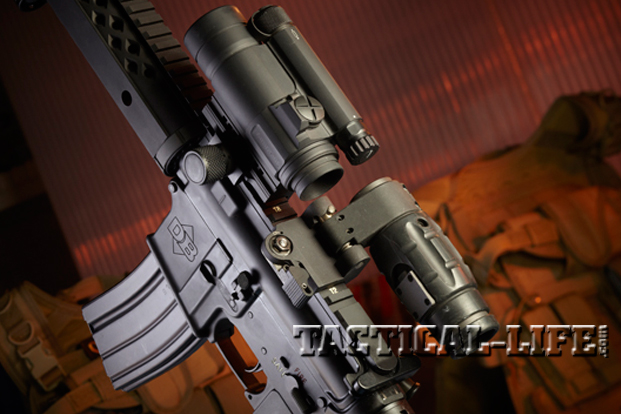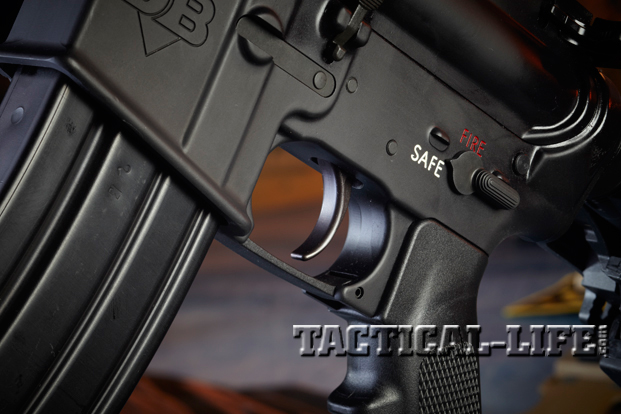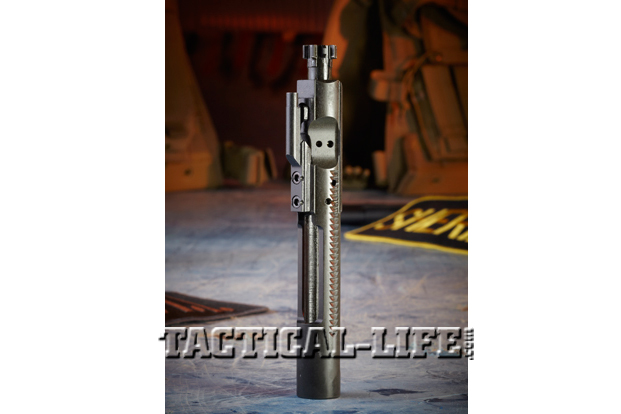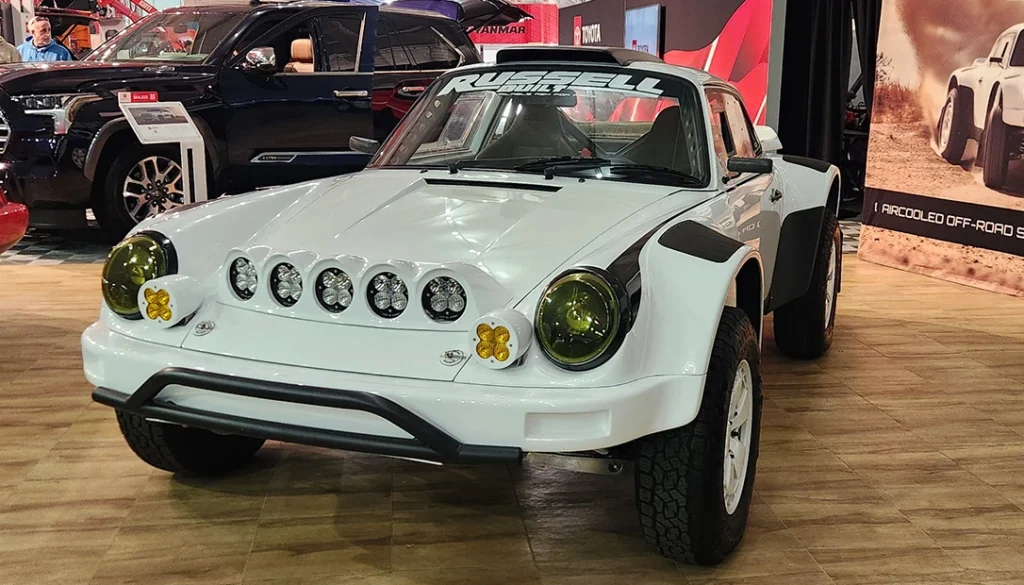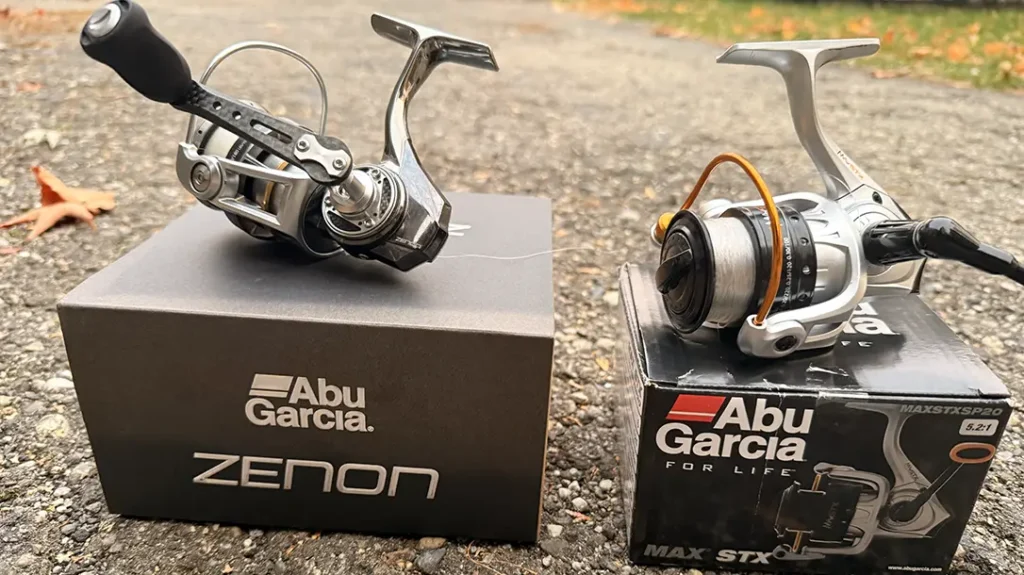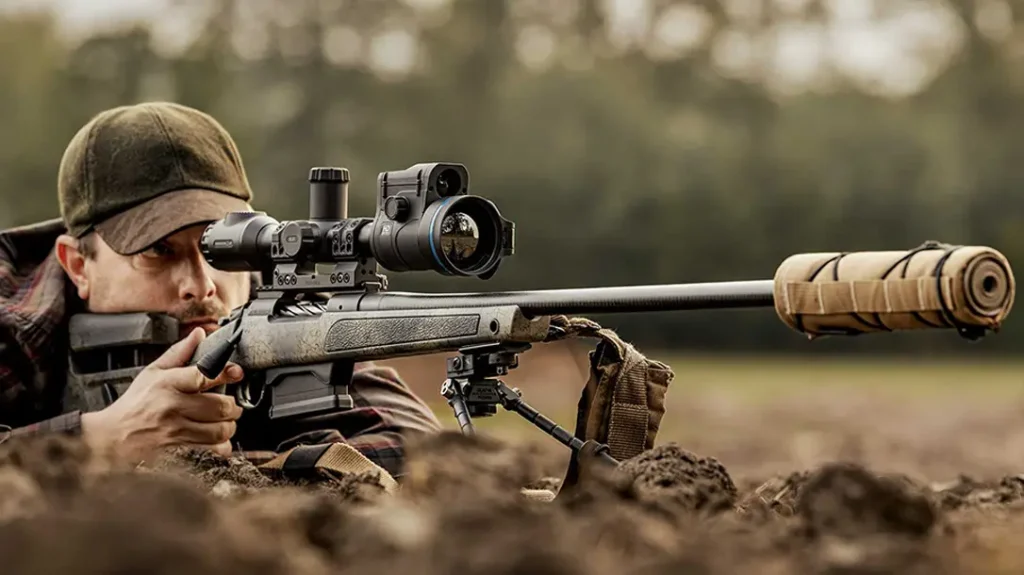Founded in 2009 and located in Cocoa, Florida, Diamondback Firearms was, until recently, a maker of handguns only. But now the company makes the DB15, an AR-15-style carbine utilizing the traditional direct gas impingement system. With a suggested retail price lower than many competitive models, it should appeal to the patrolman or department that is on a tight budget.
The DB15 sports a T-marked Picatinny rail on its flattop receiver, which is machined from forged 7075-T6 aluminum and is nicely anodized. The T-markings facilitate the removal and replacement of optics in the same place.
There will be no mistaking the “safe” and “fire” positions on the DB15 because the lower receiver is marked in big red letters on both sides with the word “fire.” Safe is likewise marked, but in white letters. The Diamondback logo is positioned on each side of the magazine well, and the right side is marked indicating the lower receiver works with multiple calibers. The magazine well is nicely beveled to aid in speedy reloads, while the magazine release is a standard AR-style that, when pressed, allows magazines to fall freely away. Cops can find themselves in a situation where a fast reload is required, and the DB15 is set up for that contingency.
Advertisement — Continue Reading Below
The receiver extension, or what some call the buffer tube, is of the larger-diameter commercial style, so if the cop wants to change buttstocks, a commercial (not mil-spec) variant is required. The tube has detents to allow the buttstock to be adjusted to one of six positions. This is an important feature for the law enforcement officer who might wear tactical body armor one day and a regular uniform the next.
Fitted to the receiver extension of my test sample is an ATI buttstock. The buttstock latch spring is fairly light, making it easy to depress, so care must be taken not to accidentally do so, especially if using a bag to rest the buttstock on when shooting from a supported prone or benched position. An adjustable saddle attached to the top of the buttstock may be raised or lowered to align the shooter’s eye directly behind the sighting system. This could be helpful if an optic were mounted high because of a large-diameter objective lens. However, if the buttstock is not extended far enough to the rear, the charging handle cannot be fully retracted because the saddle interferes with it. If you like the saddle, leave it there. If you don’t, take it off.
The receiver is mated to a one-piece, black anodized aluminum handguard that has a Picatinny rail running along its top, making it possible to mount optics or accessories like a laser—for those agencies that use them—or a front sight. The handguard is ventilated to help cool the barrel and is comfortable to handle because it does not have rails running along its sides or bottom. However, at the front of the handguard, at the 3, 6 and 9 o’clock positions are 2-inch rails onto which may be mounted accessories like a foregrip, a bipod or a light—which is often a requirement for law enforcement.
Advertisement — Continue Reading Below
The 16-inch, M4-profile barrel, with its M203 grenade launcher cut, is manufactured from 4140 chrome-moly steel and has a 1-in-9-inch twist rate, which works well and is used by many manufacturers. The barrel is finished in Melonite, a very hard and rust-resistive metal treatment that eliminates the need for a chrome lining. The barrel is marked as being chambered for 5.56mm NATO, so those law enforcement agencies that use either .223 Remington or 5.56mm NATO loads are covered. An A2-style flash suppressor is mounted at the muzzle end. At the breech end, the receiver has M4 feed ramps to promote reliable feeding.
Within the buffer tube are the buffer spring and a standard (not heavy) weight buffer that absorb the energy of the bolt carrier during its rearward travel. Diamondback’s website indicates that the bolt carrier meets military specifications, is shot peened, magnetic-particle inspected and is made of 8620 steel. The all-important gas key screws are properly staked, and the carrier group is manganese-phosphate finished. The gas key and bolt carrier also look like they are chromed lined. These are important features for the officer who might employ the weapon in harsh environments where failure can be catastrophic.
The gun was delivered in a hard polymer, foam-lined carrying case along with a chamber flag, the required safety lock, an owner’s manual and a 30-round, standard-capacity magazine with an orange anti-tilt follower. The magazine was made in the U.S.A. and worked properly.
Advertisement — Continue Reading Below
The gun is available in black, like the gun I received for testing, or Flat Dark Earth. And, although Diamondback has an option for iron sights, the test unit came without sights, which helps to keep costs down and also allows users to outfit the gun with their preferred sights. I chose to install GG&G’s flip-up front and Multiple Aperture Device (MAD) rear sights, which are solidly built and can be folded out of the way for those who don’t like to run with them up. A nice feature of these sights is that they lock rigidly in place when deployed and can be adjusted for windage and elevation. The MAD rear sight has two apertures—a large and a small one—but they are in the same plane, unlike the standard A2 sight, where switching moves the point of impact up or down. With the GG&G sights, the point of impact remains the same, which eliminates a variable that can cause confusion and misses if, in a stressful situation, the officer forgets about the change.
The primary optic I chose for this test was an EOTech XPS3 with a 65-MOA circle and 1-MOA dot reticle that is lightning-fast for close work, yet allows precision shots at longer ranges. Although the optic is not magnified, a well-trained shooter can place rounds precisely at longer ranges as long as the target isn’t the size of a field mouse.
Range Time
Advertisement — Continue Reading Below
The gun was test-fired off a bench to evaluate its accuracy and then in a series of tactical drills to determine how well it handled. The EOTech XPS3 was used for both phases of testing instead of a magnified scope for the accuracy phase. Because the center dot of the XPS3 is only 1 MOA in diameter and the test range was only 100 yards, the optic is adequate for a carbine that is not built to be a precision rifle. At 100 yards, the dot covers only a 1-inch-diameter spot.
It turned out that this carbine produced entirely acceptable accuracy, averaging about 1.75-inch groups with the ammunition it liked best, Black Hills’ 77-grain Open Tip Match (OTM) load. That’s the civilian equivalent of the military Mk 262 Mod 1 round that gets such good reviews from people who use it in real conflicts. Hornady’s 75-grain Match boat-tail hollow-point (BTHP) ammunition also printed pretty good groups, averaging just under 2 inches. Winchester 60-grain PDX1 Defender hollow-point ammunition did not do as well, averaging groups of around 5 inches. What is interesting is that the slower 1-in-9-inch twist rate is designed to stabilize bullets weighing less than the other two rounds, but in this case, the heavier bullets did better. It is not unusual for a gun to be more or less accurate with a given brand of ammunition, so this is not a criticism of the gun or the ammo—it is just an interesting observation.
Testing in tactical drills was uneventful. I found that the carbine allowed me to quickly acquire a sight picture, and the handguard was comfortable to grip because of its round profile. In the end, the gun worked properly every time the trigger was pulled, with no malfunctions or other problems. The trigger broke cleanly at 9 pounds with little discernible take-up and only a bit of overtravel.
Advertisement — Continue Reading Below
The bottom line is that my test DB15 worked properly and was accurate with ammunition it liked. For a patrol officer or a law enforcement agency that is on a tight budget, the Diamondback DB15 could be a relatively inexpensive basic platform for a patrol carbine. With the number of aftermarket parts and accessories available, the gun can be customized to suit the user’s requirements. For more information, call 877-997-6774 or visit diamondbackfirearms.com.
